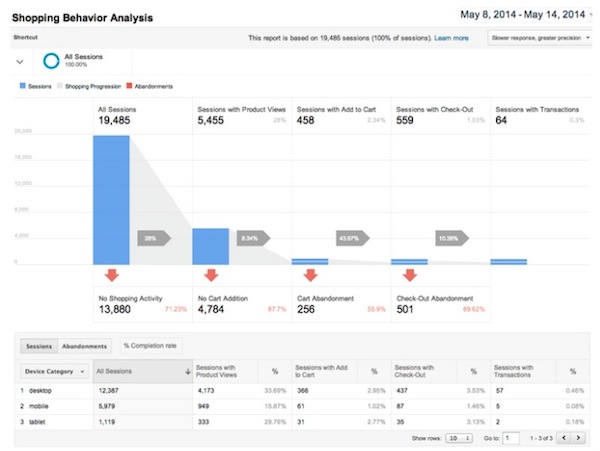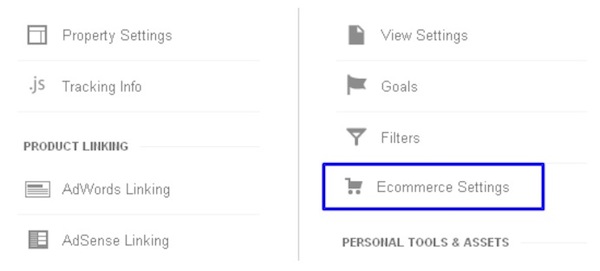Google Analytics has recently launched a new feature for ecommerce store owners, named “Enhanced Ecommerce”. As a matter of fact, it’s a lot more than a simple feature. It’s the opening to a whole new world of statistics, insights, and conversion optimization opportunities for ecommerce sellers.
If you are one of those very few businesses, which have already started to use this feature to the fullest, then this post is not for you. But since the feature is fairly new, and quite complicated, chances are that you are still in the phase of ignoring and pretending that it’s one of those overly technical feature meant for big brands and large ecommerce stores.
Truth is, Enhanced Ecommerce is equally beneficial and important for small ecommerce stores. And by ignoring this feature, you will be closing your eyes to some practical steps that you can take to drastically improve your conversions.
Just have a look at the following benefits and tell … why an ecommerce store would not want to have such valuable information?
- You will get to know the behavior of your customers before they make a purchase (or vice versa).
- You can see how, when, and where the customers are initiating or abandoning the purchase process. A quick look at the shopping behavior report will reveal the stage in your sales funnel that’s letting go the maximum number of visitors.
- You can see how your visitors are engaging with your products. For example, you will be able to see the conversion rate for a particular product by looking at total number of views and comparing it with the total sales for that particular product.
- You will be able to get detailed reports like the average order value, average number of products in a transaction, and the percentage of users who’ve added products to carts. All of this information will let you identify products with some potential that is not getting realized.
- Affiliate code report will let you know the transactions, revenues, and average order value from affiliates who are sending visitors to your website.
- You can also generate product coupon reports to see if coupon codes are helping in terms of purchases, and profit revenue per purchase.
Enhanced Ecommerce vs. the Old Ecommerce Data in Analytics
If you were using ecommerce feature in Analytics, you’d know that all you’ve had in the past was the data after a transaction took place. You weren’t able to track or monitor customers before the sale, but now you can monitor the entire lifecycle from landing on your website to as far as refunds, and that’s a major development. For example, knowing when and why the customers are leaving your sales funnel is the first step towards blocking the outflow.
As you can see in this sample report, out of 19k+ visitors, only 5455 visitors got to the product view stage, but the real drop occurs after that, when only 458 visitor adding to cart.
If you see a product that is viewed a lot, but didn’t have the kind of sales that you’d expect after so many views, you’d know that the product has some potential, so you can try slashing the price a bit and see if it works.
And that’s just the tip of the iceberg. The more you spend time with it, the more possibilities you will discover.
You can try this free course in Analytics Academy for more tips and tricks.
Setting up Enhanced Ecommerce Feature
You won’t start getting this feature in your Analytics by default. You need to set it up, and the setup is slightly more complex than installing analytics, but that shouldn’t stop you from using this mighty feature..
The first step is to migrate your website to Universal Analytics from the old one, because Enhanced Ecommerce is available only in Universal Analytics (skip this step if you are already using Universal Analytics).
Next you will have to install Enhanced Ecommerce plugin by following the instructions at this page. You can see, you will have to install a number of codes for different types of reports or trackings e.g. actions like adding or removing a product from shopping cart, product impressions, product clicks, and different steps in your checkout process.
As earlier mentioned, installing ecommerce tracking is a little more complex than the simple Analytics installation. So it’s better to let your developer handle it for you.
Once all these codes and trackings are in place, you can go to your Analytics admin, and click on ecommerce Settings in the View section.
You will be taken to the following page, click on edit and enable ecommerce. Simply “switch on” the button and click on next step.
As easy as it can get …

Turn on the Enhanced Ecommerce option in the similar manner and you will start getting the enhanced ecommerce data in your analytics.
Luckily, some popular ecommerce platforms have partnered with Google.
In case you are using one of these platforms, you can use Enhanced Ecommerce without having to deal with all those installations and setting-up procedure.
Magento:
If your online store is powered by Magento, you can use this free plugin to install ecommerce tracking. You will have to register with Google Analytics and install Universal Analytics on your store before installing this plugin.
Shopify:
Shopify has this paid app for Shopify store owners who want to use advance features of Google Analytics. The app is easy to install and you will get lots and lots of powerful features.
PrestaShop:
PrestaShop is an open source ecommerce software. If you are using PrestaShop, you can use their free app to be able to use Analytics including enhanced ecommerce tracking.
WordPress:
If your store is powered by WordPress and WooCommerce, you can try this plugin.
Mshopper:
Mshopper is known for its mobile commerce technologies. mStore v4.1 is a paid solution by Mshopper that allows you to set up mobile friendly stores, and it comes with built in integration with Enhanced Ecommerce Analytics tool.
Feature image curtsey of Nick Slater






Hi, thanks for the great article. Is the Google Analytics app by prestashop still active or available? I can´t find it anymore. Which module / app would you recommend instead? Would you use an app or install by hand with the google tagmanager? best regards Patrick
Hi Patrick,
Yep, it’s still available. See the link here.
Cheers,
Bogdan – Editor at ecommerce-platforms.com